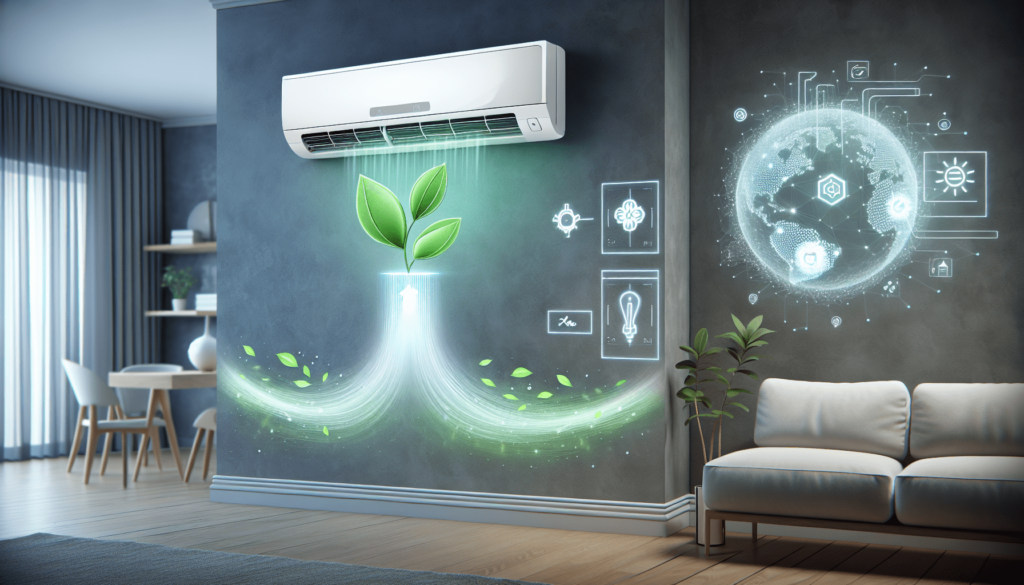Are you considering installing a mini-split AC system in your home or office? Before making a decision, it’s crucial to understand the environmental impact of these systems. While mini-split AC systems offer several benefits, such as energy efficiency and individual room temperature control, it’s essential to be aware of their impact on the environment. In this article, we will explore the environmental aspects of mini-split AC systems, providing you with the information you need to make an informed choice. Whether you’re an eco-conscious individual or simply want to minimize your carbon footprint, understanding the environmental impact of mini-split AC systems is key. So, let’s dive in and discover what you need to know!

This image is property of pixabay.com.
Understanding Mini-Split AC Systems
Definition and working principle of Mini-Split AC Systems
Mini-Split AC Systems, also known as ductless AC systems, are highly efficient air conditioning units designed for individual rooms or zones. Unlike traditional AC systems that require ductwork to distribute cool air throughout a building, mini-split systems consist of an indoor unit and an outdoor compressor. The indoor unit is mounted on a wall or ceiling and is connected to the outdoor compressor through refrigerant lines. This configuration allows for the cooling of individual areas without the need for extensive ductwork.
The working principle of mini-split AC systems involves the circulation of refrigerant within the system to transfer heat from the indoor area to the outdoor atmosphere. The compressor in the outdoor unit compresses the refrigerant, raising its temperature. This hot refrigerant is then passed through the coils of the indoor unit, where it absorbs the heat from the room’s air, cooling it in the process. The cooled air is then released back into the room, providing a comfortable indoor environment.
Types of Mini-Split AC Systems
There are various types of mini-split AC systems available in the market, each suited for different purposes and requirements. The most common types include single-zone mini-splits and multi-zone mini-splits.
Single-zone mini-splits are designed to cool a single room or space. They consist of one indoor unit and one outdoor compressor, offering a simple and cost-effective solution for cooling individual areas.
In contrast, multi-zone mini-splits are capable of cooling multiple rooms or zones simultaneously. They consist of multiple indoor units, each connected to the outdoor compressor. This allows for independent temperature control in different areas, catering to the specific needs and preferences of each occupant.
Factors influencing the efficacy of Mini-Split AC Systems
Several factors can influence the efficacy and performance of mini-split AC systems. The size of the indoor unit should be appropriately matched to the room’s size to ensure efficient cooling. Insulation plays a crucial role as well, as poorly insulated rooms can lead to increased energy consumption and reduced cooling efficiency. Additionally, the proper placement of the indoor unit and regular maintenance of the system are essential for optimal performance and longevity.
The Energy Efficiency of Mini-Split AC Systems
How Mini-Split AC Systems Save Energy
Mini-split AC systems are known for their energy-saving capabilities. Unlike central AC systems, which cool an entire building, mini-splits only cool specific areas, reducing energy waste. Additionally, ductless mini-splits eliminate the energy loss associated with air ducts, which can account for up to 30% of energy consumption in traditional systems. By directly delivering cooled air to the desired space, mini-split AC systems minimize energy waste and ensure efficient cooling.
Energy Star Certification and Energy Efficiency Ratio (EER)
Energy Star Certification is a trusted mark that identifies energy-efficient products, including mini-split AC systems. Products with Energy Star Certification meet or exceed strict guidelines set by the Environmental Protection Agency (EPA) for energy efficiency. Choosing an Energy Star-certified mini-split AC system ensures that you are investing in an environmentally-friendly and energy-saving solution.
The Energy Efficiency Ratio (EER) is another important aspect to consider when evaluating the energy efficiency of mini-split AC systems. The EER measures the cooling output of the system divided by its electrical power input. Higher EER values signify greater energy efficiency, indicating that the system can provide more cooling power for each unit of energy consumed.
Case Studies on Mini-Split AC Systems Energy Efficiency
Numerous case studies have demonstrated the energy-saving benefits of mini-split AC systems. In a study conducted by the National Institute of Standards and Technology (NIST), energy consumption was compared between mini-split AC systems and conventional window units. The results showed that mini-splits consumed 30% to 50% less energy, highlighting their superior efficiency in providing cooling with reduced environmental impact.
Another case study conducted by the Pacific Northwest National Laboratory (PNNL) compared the energy consumption of mini-split AC systems and central AC systems in residential buildings. The study found that mini-splits demonstrated energy savings of up to 40% compared to central AC systems, emphasizing their potential for substantial energy reduction.
Greenhouse Gas Emissions and Mini-Split AC Systems
Carbon Footprint of Mini-Split AC Systems
The carbon footprint of mini-split AC systems is significantly lower compared to traditional AC systems. As mentioned earlier, mini-splits eliminate the energy losses associated with ductwork, resulting in lower energy consumption. Reduced energy consumption equates to lower carbon dioxide (CO2) emissions, as the burning of fossil fuels to generate electricity is a significant source of CO2 emissions. By opting for mini-split AC systems, you can significantly reduce your carbon footprint and contribute to combating climate change.
The Types of Refrigerants used and their Environmental Impact
Refrigerants play a crucial role in the environmental impact of AC systems. Older AC systems commonly used hydrochlorofluorocarbons (HCFCs) and hydrofluorocarbons (HFCs) as refrigerants, both of which have a high global warming potential (GWP). These refrigerants contribute to the depletion of the ozone layer and are potent greenhouse gases.
On the other hand, newer mini-split AC systems often utilize more environmentally-friendly refrigerants, such as R-32. R-32 has a significantly lower GWP compared to older refrigerants, making it a more sustainable choice. The transition to low-GWP refrigerants in mini-split AC systems is a positive step towards reducing environmental impact and protecting the ozone layer.
Minimizing CO2 Emissions with Mini-Split AC Systems
The reduced energy consumption and utilization of low-GWP refrigerants in mini-split AC systems contribute to the minimization of CO2 emissions. By choosing an energy-efficient mini-split AC system with environmentally-friendly refrigerants, you can significantly reduce your carbon footprint and help mitigate climate change. Additionally, regular maintenance and proper usage of the system, such as setting reasonable temperature levels and utilizing energy-saving features, can further minimize CO2 emissions.
Life Cycle Analysis of Mini-Split AC Systems
Manufacturing Process and its Environmental Consequences
The manufacturing process of mini-split AC systems involves the extraction and processing of raw materials, electricity consumption during production, and transportation of components. These processes can have various environmental consequences, including the release of greenhouse gases, energy consumption, and carbon emissions.
However, advancements in manufacturing technologies and increasing focus on sustainability have led to more eco-friendly production practices. Manufacturers are adopting measures to minimize waste, optimize energy efficiency, and utilize renewable energy sources to power their facilities. By choosing mini-split AC systems from environmentally-conscious manufacturers, you can contribute to supporting sustainable manufacturing processes.
Usage Phase and its Environmental Implications
The usage phase of mini-split AC systems has both positive and negative environmental implications. On one hand, the energy-saving features and efficiency of mini-splits reduce energy consumption and associated CO2 emissions. This contributes to a more sustainable and environmentally-friendly cooling solution.
However, it is important to note that improper usage and excessive reliance on AC systems can lead to increased energy consumption and environmental impact. Setting appropriate temperature levels, implementing energy-saving practices, and using the system judiciously can help mitigate these negative environmental implications.
Recycling and Disposal Impact
Proper recycling and disposal of mini-split AC systems are essential to minimize their environmental impact. Disposal of these systems in landfills can lead to the release of harmful substances, such as refrigerants and metals, into the environment. Responsible recycling allows for the recovery of valuable materials and ensures the proper handling of hazardous components.
Manufacturers and recycling programs are increasingly implementing initiatives to facilitate the recycling and disposal of AC systems. It is important to consult local regulations and guidelines to ensure the proper disposal or recycling of your mini-split AC system at the end of its lifecycle.

This image is property of pixabay.com.
Understanding the R-32 Refrigerant
How R-32 is Used in Mini-Split AC Systems
R-32 is a next-generation refrigerant widely used in mini-split AC systems due to its environmental benefits. It has a lower GWP compared to previous refrigerants, meaning it has a reduced impact on climate change. R-32 also exhibits higher energy efficiency and better cooling performance, making it an attractive choice for manufacturers and consumers alike.
The use of R-32 in mini-split AC systems allows for improved energy efficiency, reduced carbon footprint, and enhanced cooling capacity. Its compatibility with the latest technological advancements in mini-split AC systems further contributes to their overall sustainability.
Environmental Benefits and Drawbacks of Using R-32
Using R-32 in mini-split AC systems presents several environmental benefits. Its lower GWP helps reduce the greenhouse gas emissions associated with cooling. R-32 also has a higher energy efficiency, resulting in lower energy consumption compared to older refrigerants. Additionally, its compatibility with new system designs allows for more compact and efficient units.
However, it is important to consider the potential drawbacks of R-32. It is mildly flammable, which calls for proper handling and installation practices to ensure safety. Strict regulations and guidelines are in place to address these concerns and ensure the safe use of R-32 in mini-split AC systems.
Regulations and Policies Surrounding Mini-Split AC Systems
International Regulations on Greenhouse Gases
International regulations and agreements are in place to mitigate the environmental impact of AC systems. The Kigali Amendment to the Montreal Protocol, signed by nearly 200 countries, aims to phase down the production and consumption of HFC refrigerants. This agreement emphasizes the transition to low-GWP refrigerants, such as R-32, in order to combat climate change and protect the ozone layer.
These international regulations and agreements encourage the adoption of environmentally-friendly technologies, including mini-split AC systems, as part of a global effort to reduce greenhouse gas emissions.
Local Legislation Impacting AC unit Use
Beyond international regulations, local legislation can also impact the use of AC units, including mini-splits. Building codes and energy efficiency standards imposed by local authorities may require certain energy-efficient features or restrictions on AC unit installations. Familiarizing yourself with these regulations and guidelines is crucial when considering the installation or replacement of a mini-split AC system. Compliance with local legislation ensures that your cooling solution meets environmental standards and contributes to sustainability efforts in your area.

This image is property of pixabay.com.
The Role of Mini-Split AC Systems in Climate Change
Underlying Relation Between AC Use and Global Warming
The use of air conditioning systems, including mini-split AC systems, contributes to global warming due to their energy consumption and associated CO2 emissions. The burning of fossil fuels to generate electricity for cooling purposes releases greenhouse gases into the atmosphere, exacerbating climate change.
However, mini-split AC systems offer a more energy-efficient alternative compared to traditional AC systems. By incorporating energy-saving features, utilizing low-GWP refrigerants, and optimizing cooling efficiency, mini-splits can help reduce the environmental impact of AC use and mitigate climate change.
How Mini-Split AC Systems Can Help Mitigate Climate Change
The adoption and use of mini-split AC systems can play a significant role in mitigating climate change. Their energy-efficient design, reduced energy consumption, and utilization of low-GWP refrigerants contribute to a lower carbon footprint. By adopting these systems, both residential and commercial buildings can reduce their energy consumption, decrease their contribution to CO2 emissions, and support sustainability efforts.
In addition to their energy-saving capabilities, mini-split AC systems can also be integrated with renewable energy sources, such as solar power. Solar-powered mini-splits utilize clean energy, further reducing reliance on fossil fuels and promoting a sustainable future.
Water Consumption and Mini-Split AC Systems
How Mini-Split AC Systems Utilize Water
Unlike some traditional AC systems that require water for cooling, mini-split AC systems do not utilize water for their operation. They rely solely on the circulation of refrigerant to provide cooling, eliminating the need for a water supply. This water-free operation ensures the conservation of water resources and reduces water consumption associated with cooling.
Associated Water Consumption Concerns
Water scarcity is a growing global concern, and the reduced water consumption of mini-split AC systems addresses this issue. Some traditional AC systems, particularly evaporative cooling systems, use significant amounts of water for cooling purposes. By opting for water-free mini-split AC systems, you can contribute to water conservation efforts and reduce the strain on water resources. This is particularly important in regions facing water scarcity or where water resources need to be allocated for other essential needs.

Innovations in Mini-Split AC Systems for Lower Environmental Impact
Developments in Energy-Efficient Designs
Continual advancements in energy-efficient designs contribute to reducing the environmental impact of mini-split AC systems. Manufacturers are incorporating state-of-the-art technologies, such as inverter-driven compressors, advanced fan designs, and smart control systems. These innovations optimize energy consumption, improve cooling efficiency, and minimize environmental impact.
Integration of sensors and smart controls allows for more precise temperature regulation and energy management, further enhancing energy efficiency. By staying abreast of the latest advancements and selecting systems with energy-saving features, you can maximize the environmental benefits of mini-split AC systems.
Advanced Refrigerants with Lower Global Warming Potential
The development and utilization of advanced refrigerants with lower GWP are key drivers in reducing the environmental impact of mini-split AC systems. Manufacturers are actively exploring and adopting refrigerants, such as R-32, that exhibit higher energy efficiency and reduced global warming potential. These advanced refrigerants offer improved cooling performance while significantly reducing greenhouse gas emissions.
By choosing mini-split AC systems equipped with low-GWP refrigerants, you support the industry’s efforts to prioritize sustainability and environmental responsibility.
Introduction of Solar-Powered Mini-Split AC Systems
The introduction of solar-powered mini-split AC systems presents a revolutionary approach to cooling with minimal environmental impact. By harnessing the power of the sun, these systems produce clean energy to operate the AC units. Solar panels capture sunlight and convert it into electricity, which can power the mini-split AC system, reducing or eliminating the need for electricity generated from fossil fuels.
Solar-powered mini-split AC systems offer a sustainable and eco-friendly solution for cooling needs, allowing you to reduce your dependence on traditional energy sources and contribute to a greener future.
Conclusion
In conclusion, mini-split AC systems offer a highly efficient and environmentally-friendly cooling solution for individual rooms or zones. Their energy-saving capabilities, utilization of low-GWP refrigerants, and reduced water consumption contribute to minimizing their environmental impact.
Understanding the energy efficiency and environmental implications of mini-split AC systems is crucial for making informed decisions. By adopting these systems, you can contribute to reducing greenhouse gas emissions, mitigating climate change, conserving water resources, and supporting sustainability efforts.
The future of mini-split AC systems lies in continued advancements in energy-efficient designs, the utilization of advanced refrigerants, and the integration of renewable energy sources. With a focus on sustainability and environmental responsibility, the industry is poised to provide even more eco-friendly cooling solutions.
Investing in a mini-split AC system is not just a choice for comfort; it is a choice for a greener and more sustainable future. Let’s embrace the environmental benefits of mini-split AC systems and make a positive impact on our planet’s health.


